Mason Carnahan
Brain Signals to Rescue Aphasia, Apraxia and Dysarthria Speech Recognition
Feb 28, 2021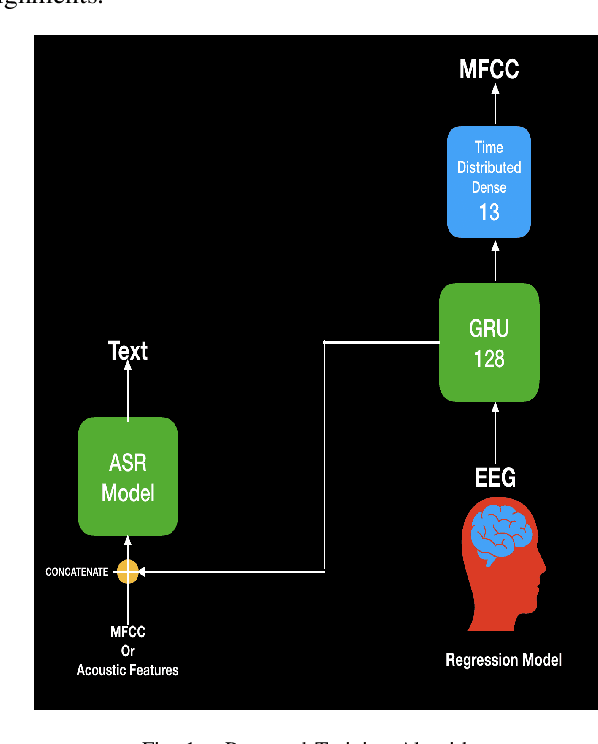
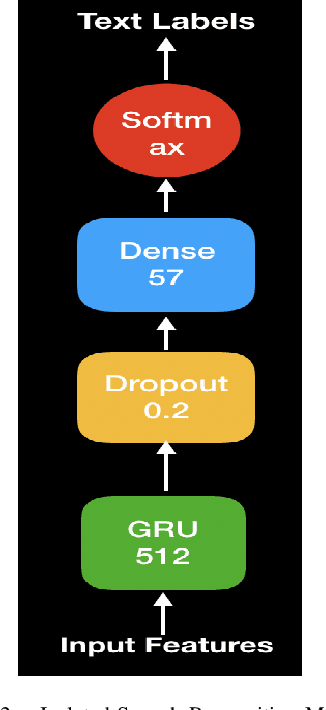
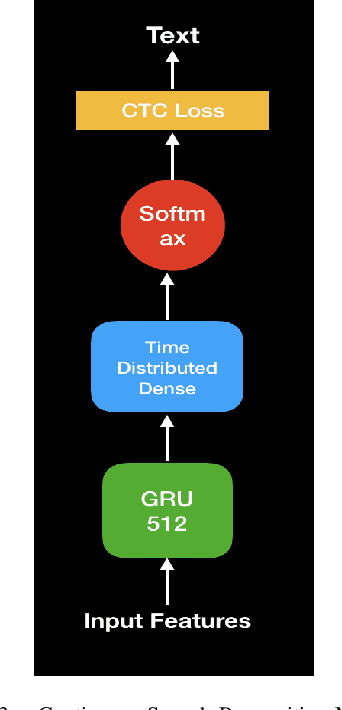
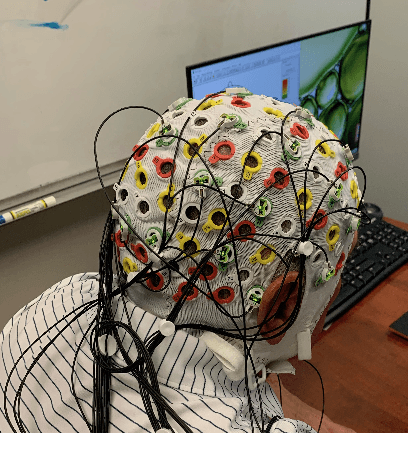
Abstract:In this paper, we propose a deep learning-based algorithm to improve the performance of automatic speech recognition (ASR) systems for aphasia, apraxia, and dysarthria speech by utilizing electroencephalography (EEG) features recorded synchronously with aphasia, apraxia, and dysarthria speech. We demonstrate a significant decoding performance improvement by more than 50\% during test time for isolated speech recognition task and we also provide preliminary results indicating performance improvement for the more challenging continuous speech recognition task by utilizing EEG features. The results presented in this paper show the first step towards demonstrating the possibility of utilizing non-invasive neural signals to design a real-time robust speech prosthetic for stroke survivors recovering from aphasia, apraxia, and dysarthria. Our aphasia, apraxia, and dysarthria speech-EEG data set will be released to the public to help further advance this interesting and crucial research.
Speech Recognition using EEG signals recorded using dry electrodes
Aug 13, 2020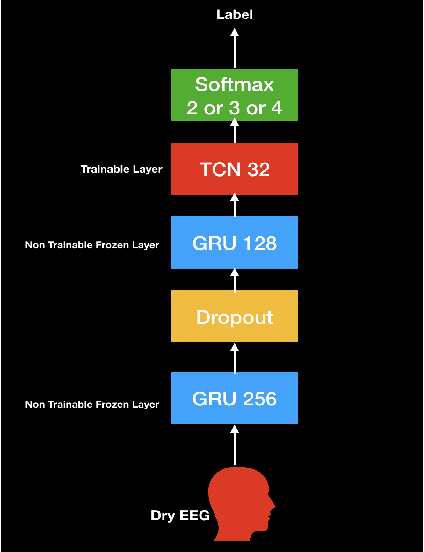
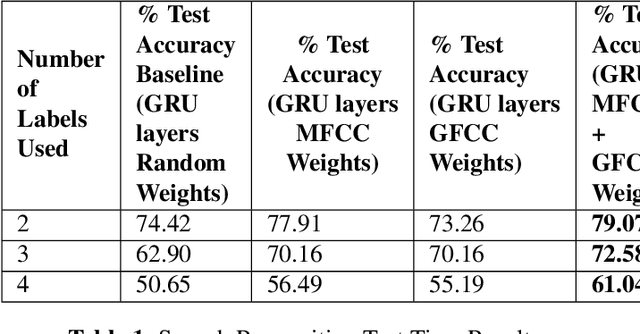
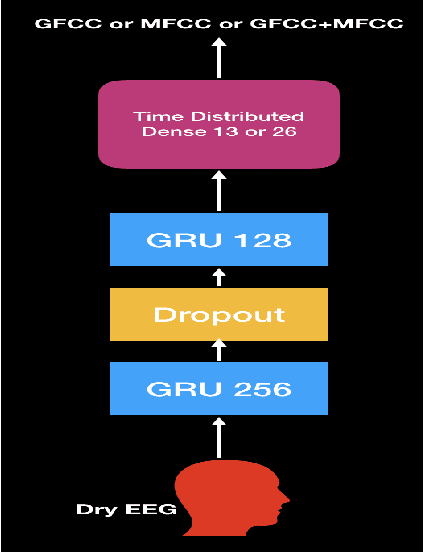
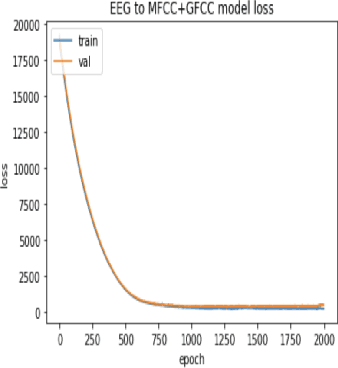
Abstract:In this paper, we demonstrate speech recognition using electroencephalography (EEG) signals obtained using dry electrodes on a limited English vocabulary consisting of three vowels and one word using a deep learning model. We demonstrate a test accuracy of 79.07 percent on a subset vocabulary consisting of two English vowels. Our results demonstrate the feasibility of using EEG signals recorded using dry electrodes for performing the task of speech recognition.
Constrained Variational Autoencoder for improving EEG based Speech Recognition Systems
Jun 01, 2020



Abstract:In this paper we introduce a recurrent neural network (RNN) based variational autoencoder (VAE) model with a new constrained loss function that can generate more meaningful electroencephalography (EEG) features from raw EEG features to improve the performance of EEG based speech recognition systems. We demonstrate that both continuous and isolated speech recognition systems trained and tested using EEG features generated from raw EEG features using our VAE model results in improved performance and we demonstrate our results for a limited English vocabulary consisting of 30 unique sentences for continuous speech recognition and for an English vocabulary consisting of 2 unique sentences for isolated speech recognition. We compare our method with another recently introduced method described by authors in [1] to improve the performance of EEG based continuous speech recognition systems and we demonstrate that our method outperforms their method as vocabulary size increases when trained and tested using the same data set. Even though we demonstrate results only for automatic speech recognition (ASR) experiments in this paper, the proposed VAE model with constrained loss function can be extended to a variety of other EEG based brain computer interface (BCI) applications.
Improving EEG based continuous speech recognition using GAN
May 29, 2020



Abstract:In this paper we demonstrate that it is possible to generate more meaningful electroencephalography (EEG) features from raw EEG features using generative adversarial networks (GAN) to improve the performance of EEG based continuous speech recognition systems. We improve the results demonstrated by authors in [1] using their data sets for for some of the test time experiments and for other cases our results were comparable with theirs. Our proposed approach can be implemented without using any additional sensor information, whereas in [1] authors used additional features like acoustic or articulatory information to improve the performance of EEG based continuous speech recognition systems.
Understanding effect of speech perception in EEG based speech recognition systems
May 29, 2020



Abstract:The electroencephalography (EEG) signals recorded in parallel with speech are used to perform isolated and continuous speech recognition. During speaking process, one also hears his or her own speech and this speech perception is also reflected in the recorded EEG signals. In this paper we investigate whether it is possible to separate out this speech perception component from EEG signals in order to design more robust EEG based speech recognition systems. We further demonstrate predicting EEG signals recorded in parallel with speaking from EEG signals recorded in parallel with passive listening and vice versa with very low normalized root mean squared error (RMSE). We finally demonstrate both isolated and continuous speech recognition using EEG signals recorded in parallel with listening, speaking and improve the previous connectionist temporal classification (CTC) model results demonstrated by authors in [1] using their data set.
Predicting Different Acoustic Features from EEG and towards direct synthesis of Audio Waveform from EEG
May 29, 2020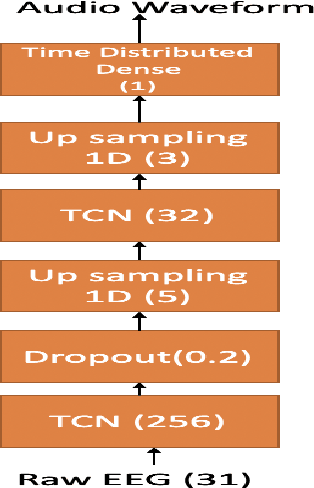
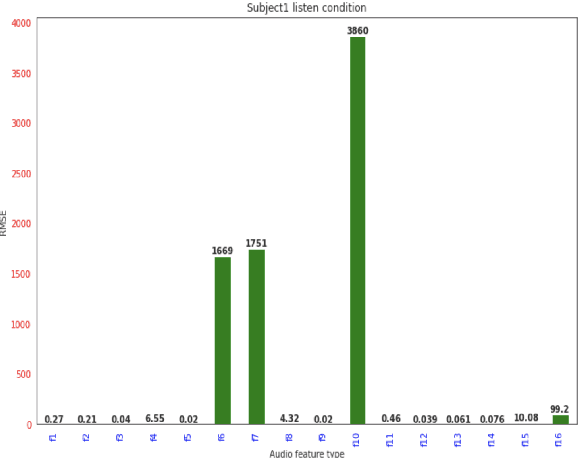
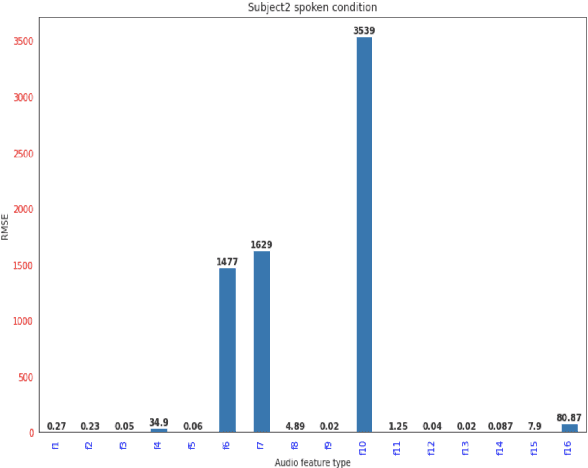
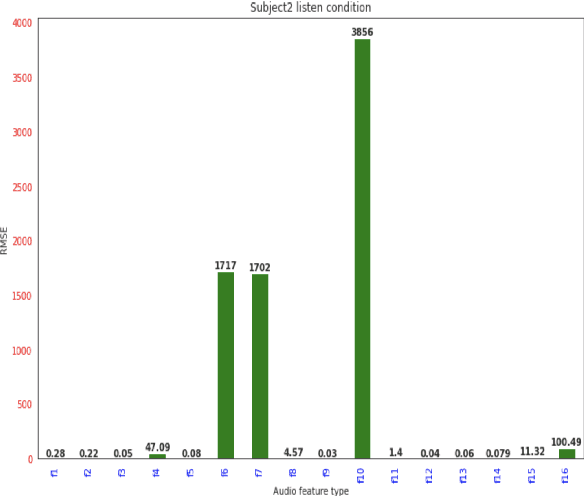
Abstract:In [1,2] authors provided preliminary results for synthesizing speech from electroencephalography (EEG) features where they first predict acoustic features from EEG features and then the speech is reconstructed from the predicted acoustic features using griffin lim reconstruction algorithm. In this paper we first introduce a deep learning model that takes raw EEG waveform signals as input and directly produces audio waveform as output. We then demonstrate predicting 16 different acoustic features from EEG features. We demonstrate our results for both spoken and listen condition in this paper. The results presented in this paper shows how different acoustic features are related to non-invasive neural EEG signals recorded during speech perception and production.
Predicting Video features from EEG and Vice versa
May 16, 2020



Abstract:In this paper we explore predicting facial or lip video features from electroencephalography (EEG) features and predicting EEG features from recorded facial or lip video frames using deep learning models. The subjects were asked to read out loud English sentences shown to them on a computer screen and their simultaneous EEG signals and facial video frames were recorded. Our model was able to generate very broad characteristics of the facial or lip video frame from input EEG features. Our results demonstrate the first step towards synthesizing high quality facial or lip video from recorded EEG features. We demonstrate results for a data set consisting of seven subjects.
Advancing Speech Synthesis using EEG
May 03, 2020



Abstract:In this paper we introduce attention-regression model to demonstrate predicting acoustic features from electroencephalography (EEG) features recorded in parallel with spoken sentences. First we demonstrate predicting acoustic features directly from EEG features using our attention model and then we demonstrate predicting acoustic features from EEG features using a two-step approach where in the first step we use our attention model to predict articulatory features from EEG features and then in second step another attention-regression model is trained to transform the predicted articulatory features to acoustic features. Our proposed attention-regression model demonstrates superior performance compared to the regression model introduced by authors in [1] when tested using their data set for majority of the subjects during test time. The results presented in this paper further advances the work described by authors in [1].
Generating EEG features from Acoustic features
Mar 19, 2020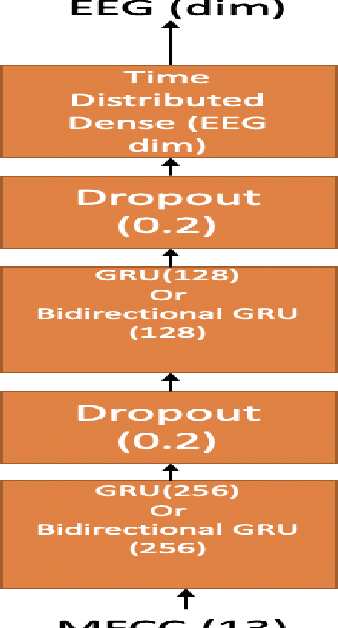
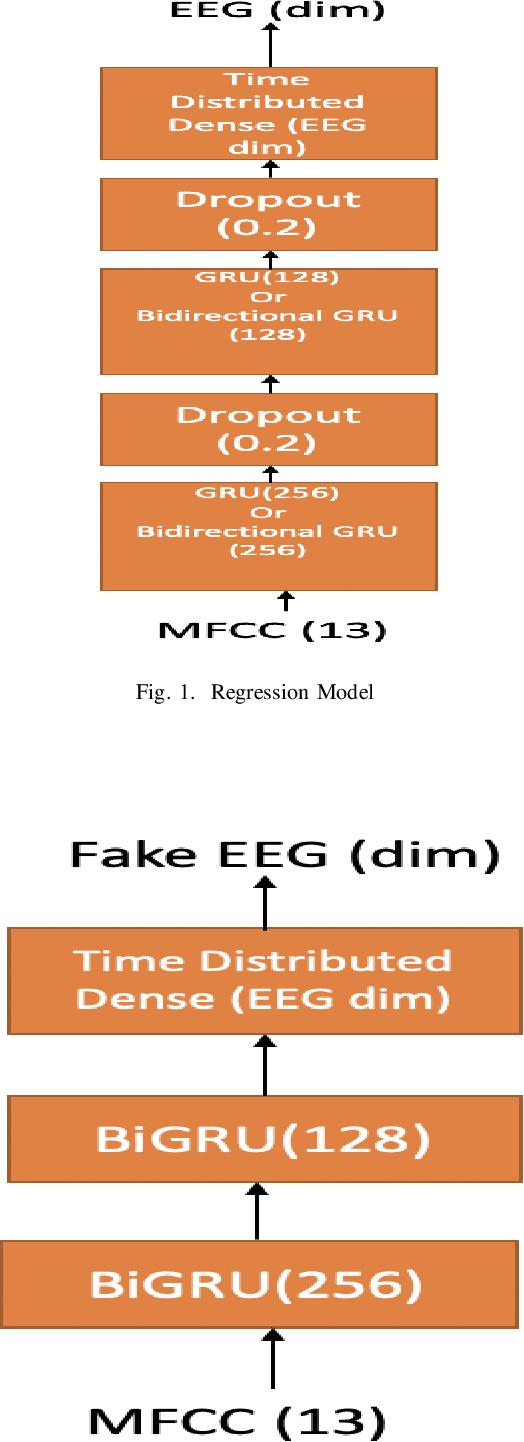
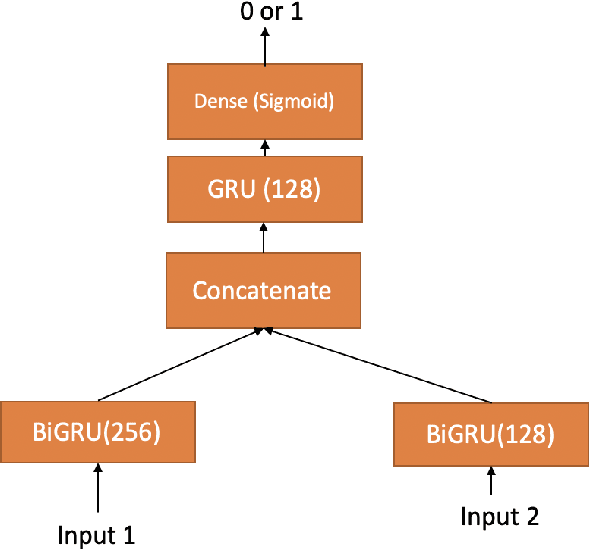
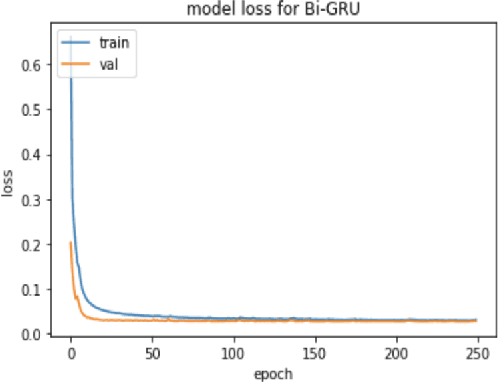
Abstract:In this paper we demonstrate predicting electroencephalograpgy (EEG) features from acoustic features using recurrent neural network (RNN) based regression model and generative adversarial network (GAN). We predict various types of EEG features from acoustic features. We compare our results with the previously studied problem on speech synthesis using EEG and our results demonstrate that EEG features can be generated from acoustic features with lower root mean square error (RMSE), normalized RMSE values compared to generating acoustic features from EEG features (ie: speech synthesis using EEG) when tested using the same data sets.
Continuous Silent Speech Recognition using EEG
Mar 15, 2020



Abstract:In this paper we explore continuous silent speech recognition using electroencephalography (EEG) signals. We implemented a connectionist temporal classification (CTC) automatic speech recognition (ASR) model to translate EEG signals recorded in parallel while subjects were reading English sentences in their mind without producing any voice to text. Our results demonstrate the feasibility of using EEG signals for performing continuous silent speech recognition. We demonstrate our results for a limited English vocabulary consisting of 30 unique sentences.
 Add to Chrome
Add to Chrome Add to Firefox
Add to Firefox Add to Edge
Add to Edge